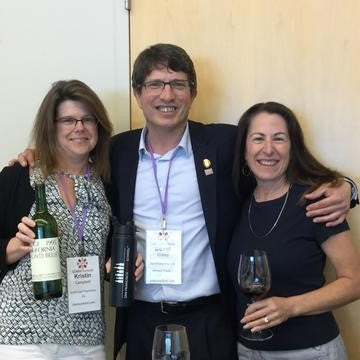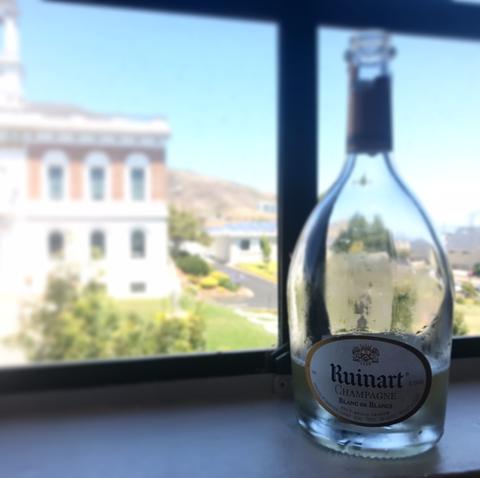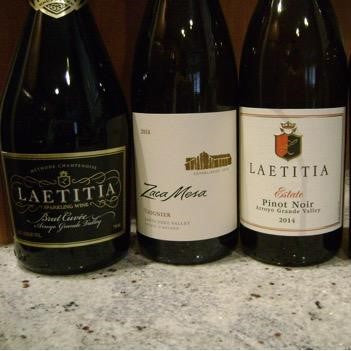by Cynthia Bournellis
When I got the call from Alexandra Pace at the San Francisco Wine School telling me that I had won two tickets to the 2017 SOMM Summit, International Wine & Spirits Symposium in Washington State—plus lodging—I was speechless. I’ve never won anything significant except for $60 playing the slot machines. The next three days of my life would truly be memorable, educational and just plain fun.
In the fall of 2016, I received my certification as a California Wine Appellation Specialist (CWAS) with Honors from the San Francisco Wine School, in South San Francisco. And while I’ve worked in the wine industry for more than 11 years and have garnered additional education from other institutions, I find that that there’s always something new to learn about the world of wine. That’s why I love it!
So when I got the news, I quickly rearranged my other priorities (I was going if it killed me), found a dear friend to join me and took off for the “Emerald City” (aka, Seattle). It all happened so fast my head was spinning, though not from wine; I was high on excitement and was long overdue for a trip.
My flight north brought back memories of another life when I worked in high tech and managed accounts in the Pacific Northwest. I’ve always enjoyed this route. I never tire of the grandeur of the snow-capped peaks and volcanoes that dot the High Country. Unfortunately smoke from what appeared to be forest fire bellowed in the distance but didn’t detract from the beauty below. Overall, the flight was pleasant, and I spent most of my time engaged in riveting conversation with an anesthesiologist—a far cry from wine but, nonetheless, fascinating.
One of my goals on this trip was to network as much as possible. The other, and foremost, was to broaden my wine education. I’m a consummate learner and love sharing my knowledge with others who are open to receiving it.
On this note, the SOMM Summit curriculum did not disappoint. The symposium was held at South Seattle College, which has a culinary arts and winemaking program. The college is in the hilly district of Seattle, west of Duwamish River and across Elliott Bay from downtown. The drive to campus each day, courtesy of free shuttles, revealed panoramic views of the Seattle city skyline, Puget Sound waterfront, and the Cascade and Olympic mountain ranges. Can’t complain about that commute!
Roughly 25 seminars were held over a three-day period, including three morning assemblies, three trade tasting receptions and two off-campus activities. Each class featured eight to 10 samples of wine in Riedel glasses, tasting templates, and more.
There were too many fascinating mid-day seminars held at the same time, and you could only pick one, so I chose those from each block with which I was least familiar. Here’s my itinerary.
Sadly, I had to pass on San Francisco Wine School founder David Glancy’s session, “Napa Elevations, Valley to Sky,” which included a cool, raised map of the Napa Valley AVA. I love maps! (Sorry David, I heard it was fabulous. Hopefully you will offer it soon in S.F.)
I did, however, attend a session that David moderated, “SOMM Journal Presents: It’s Not About the Fruit,” featuring experts representing Italy, Romania, Hungary, Uruguay and Portugal.

The focus was on everything but the fruit such as time in bottle, vineyard selection, reductive winemaking and corks.
Take time in bottle, for instance. I learned that time greatly impacts Frascati, an ancient wine born in the Roman hills. The first wine we tasted, 2014 Fontana Candida Frascati, while not old, was a decent example of how Frascati begins to age gracefully. The wine is aged one year in bottle in caves carved out of tufa soil, composed of volcanic ash and sand. As it ages, Frascati takes on honeyed, reductive notes. The 2014 exhibits unctuous aromas of honeysuckle, white flowers, peach and apricot, and has a long butterscotch finish.
 Fontana Candida Cave. (photo, courtesy Banfi Vintners)
Fontana Candida Cave. (photo, courtesy Banfi Vintners)
The tasting consisted of six wines:

(left to right) 2014 Luna Mater Frascati Superiore Riserva, Fontana Candida; 2014 Jidvei Maria Owner’s Choice Pinot Gris, Romania; 2015 MA'D Furmint, Tokaji, Hungary; 2015 Bodega Garzón’s Tannat Reserve, Uruguay; 2012 Vigneto di Campolungo Chianti Classico Gran Selezione DOCG, Lamole di Lamole; 1995 Montebello Cabernet Sauvignon, Ridge Vineyards, Santa Cruz Mountains (courtesy of Matt Stamp, representing the cork council.) (photo, Cynthia Bournellis).
Before I continue, I want to thank Christopher Chan, founder and director of SOMM Summit, for his gracious gift of both the Symposium tickets and lodging at the Maxwell Hotel, where the robes and beds are to die for and the location is two blocks from the Space Needle.
Back to Washington: I have a confession to make, I’ve never had a wine from Washington State—at least not that I can recall. On the domestic front, I’ve tasted Oregon, Arizona, Virginia, New Mexico, the Finger Lakes, and of course California wines, to name some. But, Washington was a new frontier for me. My education of this region began at “A Taste of Washington: The Birth of Washington State Terroir.” This session was an eye-opener in regard to how the Columbia Basin was formed. I love all of this geology stuff and how it impacts terroir.
 Cynthia Bournellis, among glasses of Merlot and Cabernet Sauvignon, eagerly awaits, “A Taste of Washington” Assembly, 2017 SOMM Summit, Seattle. (photo: Cynthia Bournellis)
Cynthia Bournellis, among glasses of Merlot and Cabernet Sauvignon, eagerly awaits, “A Taste of Washington” Assembly, 2017 SOMM Summit, Seattle. (photo: Cynthia Bournellis)
Geologist Dr. Kevin Pogue, whose focus is on basalt and the climate/soil chemistry of Columbia Basin vineyards, explained how the basin was formed: The land here is barren and composed of basalt made from silt that was caused by grinding glaciers, and is dotted with large granite rocks that were once deposited by ice bergs. Surface soils are dominated by “loess” soils made from fine sand and silt. The Columbia Valley in eastern Washington is the state’s largest grape growing region. Vines are planted on Eloian (wind-derived) soil. Eloian is derived from the name of the Greek God, Aeolus, keeper of the winds. Most grapes are own-rooted because there is little clay, thus no phylloxera. This continental climate is home to Merlot, Syrah, Zinfandel and Cabernet Sauvignon vines. Dr. Kevin Pogue watches loess dirt in flight, Columbia Basin, Washington. (photo, courtesy of Dr. Pogue)
Dr. Kevin Pogue watches loess dirt in flight, Columbia Basin, Washington. (photo, courtesy of Dr. Pogue)
Tim Donahue, director of winemaking at College Cellars, a teaching winery on the Walla Wall Community College campus in Washington, led the second half of the assembly with a tasting of seven wines made by his enology students. Tim’s animated and vivacious speaking style, sprinkled with humor, held everyone’s attention. Especially his Lego slides.
With the help of Steve Price, phenoloic consultant for ETS Labs, Tim’s presentation contained analogies of Lego structures representing wine phenolics: anthocyanins, catechin and epicatechin, and tannin. I understand phenolics, but pictures really are worth a thousand words, albeit their simplicity.
These next few images from Tim’s presentation help define wine chemistry in layman’s terms, and as it related to the practical tasting to come—a vintage variation of three Merlots: 2010 (cool year), 2012 (warm year) and 2014 (hot year); and a site variation of 2015 Cabernet Sauvignon, all clone 8, from the following vineyards: Clarke, Seven Hills, Summit View and Center (an ice wine vineyard).

A huge castle built from tons of Legos = huge tannins, those flavonoid polymers found naturally in grape skins and seeds. (image, courtesy of Tim Donahue)
Catechin and epicatechin—represented by Lego foundations—are the primary components for tannin. (image, courtesy of Tim Donahue)
High concentrations of anthocyanins (as represented by Lego pirates) are essential for good color in wine. Lots of pirates = great color. (image, courtesy of Tim Donahue)
The more modified the anthocyanins, the less astringent the wine. Malbec and Syrah are less astringent; Nebbiolo is more astringent. (image, courtesy of Tim Donahue)
A Taste of British Columbia
What better way to start the next session than with bubbles. A refreshing glass of 2010 Stellar’s Jay Brut from Sumac Ridge Estate Winery—Pinot Blanc, Chardonnay and Pinot Noir—was placed in my hand upon entering “A Tasting Tour with Wines of British Columbia.” While the Brut wasn’t part of the practical tasting, host Rhys Pender, MW and owner of WinePlus+, a B.C.-based wine education and consulting company, explained that Sumac Ridge was the first Okanagan winery to produce premium sparkling wines.
 Rhys Pender gives an overview of the British Columbia wine industry prior to the practical tasting.
Rhys Pender gives an overview of the British Columbia wine industry prior to the practical tasting.
 Okanagan Valley. (photo, courtesy of Wines of British Columbia, WineBC.com)
Okanagan Valley. (photo, courtesy of Wines of British Columbia, WineBC.com)
My thoughts returned to Seattle and our nine-wine flight. By far, my favorite was the 2014 Tantalus Old Vines Riesling, Okanagan Valley. Bone dry, I loved it for its racy acidity and stony minerality. I also loved the colorful and informative tasting mat.



Ooh La La, Syrah!
I love Syrah, so I was looking forward to the session, “Washington State—The New Northern Rhone,” hosted by Joel Butler, MS. The tasting consisted of seven wines. What impressed me were the two wines made from grapes grown in The Rocks District AVA, nestled in the Walla Walla AVA and entirely in Oregon.
Boundaries define this district. According to Geologist Dr. Pogue, “The Rocks District is the only AVA in the United States whose boundaries have been fixed by virtue of a single soil series and a single land form.” The soil series is Freewater and the land form is alluvial fan.

Syrah tasting (left to right): 2014 Betz Family Winery, Cote Patriache, Red Willow Vineyard, Yakima Valley; 2015 Alain Graillot Syrah, Crozes-Hermitage, N. Rhone; 2014 Betz Family Winery Syrah, La Serenne, Boushey Vineyard, Yakima Valley; 2014 Avennia Syrah Arnaut, Boushey Vineyard, Yakima Valley; 2014 Amavi Cellars Syrah, Les Collines Vineyard, Walla Walla; 2015 Rotie Cellars Nothern Blend, Rocks District of Milton-Freewater, Oregon; 2014 Saviah Cellars Syrah, The Funk, Rocks District of Milton-Freewater, Oregon.
Bubbles Galore! Sparkling Wines of South Africa
One of the rules of the SOMM Summit (as with any wine conference) is that participants are required to taste and spit, to avoid getting intoxicated and possibly thrown out. I agree, but come on? When it comes to bubbles do the rules really apply?
Confession #2: I consumed all but two of the eight generous samples. I doubt I wasn’t alone. (Don’t worry Christopher, I didn’t get buzzed. I had a hearty breakfast knowing that this session would be in the morning.)
These wines are made in the Methode Cap Classique (MCC) process, which are South African sparkling wines made by the traditional Champagne method, with some differences, including: All varieties are allowed—but Chardonnay, Chenin Blanc and Pinot Noir dominate. Minimum time on the lees is 12 months in bottle (vs.15 months for Champagne); will increase to 15 months in 2018. Whole bunch pressing is preferred.
My favorite was the Brut NV from MAN Family Wines, oddly named after three women: Marie, Anette and Nicky. Made from 100 percent Chenin Blanc, this sparkling has that racy acidity, minerality and salinity that I love. A touch of lemon citrus excites the palate.
The only disappointing element was that all of the wines were poured ahead of time rather than one at a time upon discussion of each wine, so as to further preserve the bubbles. But, they were still yummy.
 First four bubbles (left to right): MAN Brut NV; 2015 Simonsig Kaapse Vonkel Brut Rosé; Graham Beck Brut Rosé NV; Boschendal Brut NV. (photo, Cynthia Bournellis)
First four bubbles (left to right): MAN Brut NV; 2015 Simonsig Kaapse Vonkel Brut Rosé; Graham Beck Brut Rosé NV; Boschendal Brut NV. (photo, Cynthia Bournellis)

Second four bubbles (left to right): 2015 House of Krone Brut Rosé; Backsberg Kosher Brut NV; Colmant Brut Chardonnay NV; Graham Beck Brut Blanc de Blancs NV. (photo, Cynthia Bournellis)
Sherry in the Morning? Why Not!
Of all of the certifications I could acquire, Sherry isn’t one of them. No offense Sherry lovers or industry at large. Sherry hadn’t been on my radar, until I took the “Lustau Sherry Certification Class,”—at, of all things, 10 a.m.
Talk about broadening my wine education. This class, led by the delightful—and somewhat Tom Cruise lookalike—Lucas Payà, brand educator for Bodegas Lustau (the House of Lustau), was the most intense of all the sessions I took. I mean, my gosh, it came with a test! In fact our tests were collected and sent back to Spain for grading. How serious is that? A Sherry certification may be in my future.

Lucas Payà, National U.S. Brand Educator, Bodegas Lustau.
I may have learned more than I will likely bestow on another human being, but I did get to taste some marvelous Sherry. And, I learned fancy terms such as “en rama,” which means “bottling wine from barrel with no extra treatment.” The term applies to biological, not oxidative, sherry. Sherry tasting (left to right): Manzanilla Papirusa, Palomino Fino, aged 5 years; Puerto Fino, Palomino Fino, aged 5 years; Fino Jarana,Palomino Fino, aged 5 years; Amontillado Los Arcos, Palomino Fino, aged 8 years; Oloroso Don Nuño, Palomino Fino, aged 12 years; San Emilio, Pedro Ximénez, aged 12 years.
Sherry tasting (left to right): Manzanilla Papirusa, Palomino Fino, aged 5 years; Puerto Fino, Palomino Fino, aged 5 years; Fino Jarana,Palomino Fino, aged 5 years; Amontillado Los Arcos, Palomino Fino, aged 8 years; Oloroso Don Nuño, Palomino Fino, aged 12 years; San Emilio, Pedro Ximénez, aged 12 years.
New Zealand: A Land Calling My Name
My last class, “Tasting & Tour with New Zealand Winegrowers,” was hosted by David Strada, USA marketing manager for New Zealand Winegrowers.
 David Strada, USA marketing manager, New Zealand Winegrowers, discusses climate and sustainability practices in New Zealand.
David Strada, USA marketing manager, New Zealand Winegrowers, discusses climate and sustainability practices in New Zealand.
Confession #3: Until now, I hadn’t tasted New Zealand Pinot Noir. I need to get out of California more! The theme of this session was…you guessed it: Pinot Noir—from Marlborough, North Canterbury and Central Otago. (A few Sauvignon Blancs were thrown in for good measure.)
According to David, the average elevation range of the vineyards in these regions is 400 feet to 1,000 feet. I found many similarities between these Pinots and those from my neck of the woods, the Santa Cruz Mountains AVA: red, dark fruit such as cherries and cranberries; spicy notes such as black pepper, herbal notes such as thyme; aromas of meat, rose petals and perfume; firm structure and acidity; and balanced tannins. These wines were intense as opposed to elegant compared with some Pinots from California and Burgundy and much younger than the Pinots I normally drink, but I did enjoy them nonetheless. My three favorites: Wither Hills, Mt. Beautiful, and Toi Toi.
 Pinot Noir tasting. The wines were actually tasted from right to left but displayed left to right. Maybe it’s an NZ thing. (left to right) 2014 Mt. Difficulty, Bannockburn, Central Otago; 2014 Carrick, Unraveled, Central Otago; 2014 Toi Toi, Clutha, Central Otago; 2015 Mt. Beautiful, North Canterbury; 2013 Villa Maria, Cellar Selection, Marlborough; 2012 Wither Hills, Marlborough.
Pinot Noir tasting. The wines were actually tasted from right to left but displayed left to right. Maybe it’s an NZ thing. (left to right) 2014 Mt. Difficulty, Bannockburn, Central Otago; 2014 Carrick, Unraveled, Central Otago; 2014 Toi Toi, Clutha, Central Otago; 2015 Mt. Beautiful, North Canterbury; 2013 Villa Maria, Cellar Selection, Marlborough; 2012 Wither Hills, Marlborough.
So there you have it. While I didn’t recap all of the sessions I attended, I highlighted those that had the most impact on my wine education, journey and palate. This event filled my senses. At times it was surreal, like when I met Madeline Puckett of Wine Folly. Other times it was funny, like when I tasted numerous Cabernets back to back during the “Seven Hills Retrospective,” “Wines of the Medoc,” and “Advanced Bordeaux” sessions, respectively. Boy, were my teeth purple! I had to slip into the restroom to brush them. But mostly, the Symposium was a gift of wine for which I will always be grateful and will never forget.



